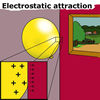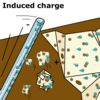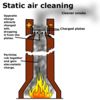|
Electrostatics
 Electrostatics is the science of static, or stationary, electricity.
Electrostatics operates in electrical insulators, and this is where
it differs from current electricity that needs electrical conductors
to facilitate electron flow.
Electrostatics is the science of static, or stationary, electricity.
Electrostatics operates in electrical insulators, and this is where
it differs from current electricity that needs electrical conductors
to facilitate electron flow.
Observing the electric
force
You can observe static electricity if you run a plastic comb through
your hair, then place the comb near small pieces of paper. The paper
is attracted to the comb. This happens because the charged comb induces
an opposite charge in the paper and as opposite charges attract, the
paper sticks to the comb. Another graphic example is rubbing a balloon
against a woolen or synthetic jumper, then putting the balloon against
a wall or the ceiling. Attraction of opposite charges holds the balloon
in place. Try holding a charged balloon over your hair for another interesting
experience! Electrostatics can be a problem, but it has very important
applications too.
 How
electrostatics works How
electrostatics works
When a comb is run through your hair charges pass between your
hair and the comb, so the comb becomes charged either positively or
negatively, and the hair oppositely charged. When the comb is brought
close to paper an opposite charge is induced in the paper, and the opposite
charges attract. The charges move from one insulator to another on vigorous
contact (i.e. by rubbing) to produce the two oppositely charged objects.
Then polarisation of charge is induced charges are induced in other
insulators close by.
Problem electrostatics
In our modern world of plastics and synthetic fibres static is a problem.
Dusting can be frustrating for example if a plastic item is rubbed with
a duster. The item becomes charged, and attracts more dust from the
air! Anti static cleaners reduce the charges so that is makes dusting
more effective. Clothes in the washer rub against each other and get
charged. When worn with different fibres they can cling together by
attraction. Additives in the rinse can again reduce the charges formed.
Technicians assembling computer components have to wear a conducting
arm band, connected to an Earth, to prevent the build up of static charges
that can be fatal to computer components.
Positive use of electrostatics
Electrostatics is used in everyday life precisely because of its charged
properties.
 The ubiquitous photocopier is a common example of putting electrostatics
to good use. Basically a charged silicon plate, formed as a drum, is
charged. Light reflects from an image on the printed page and this produces
a variation in charges in the same pattern as the printed page on the
drum. A powder (toner) is sprayed over the drum, taking up the pattern
stored on the drum. This pattern is then transferred to a sheet of blank
paper as the paper is rolled over the drum. The toner is then heated
to fuse it to the paper and an exact copy is produced - all by electrostatics.
A laser printer works in a similar fashion.
The ubiquitous photocopier is a common example of putting electrostatics
to good use. Basically a charged silicon plate, formed as a drum, is
charged. Light reflects from an image on the printed page and this produces
a variation in charges in the same pattern as the printed page on the
drum. A powder (toner) is sprayed over the drum, taking up the pattern
stored on the drum. This pattern is then transferred to a sheet of blank
paper as the paper is rolled over the drum. The toner is then heated
to fuse it to the paper and an exact copy is produced - all by electrostatics.
A laser printer works in a similar fashion.
The spray painting of cars is also much more efficient by utilising
the electrostatic charges formed as the paint leaves the spray gun.
The car frame is charged oppositely to that of the paint droplets. The
paint is then attracted to the frame, saving loss at the edges and ensuring
that the paint penetrates all the inward folds that might otherwise
be missed.
 Clean air is a major environmental concern with industry burning
fossil fuels generating ash particles that can pass into the atmosphere.
Now electrostatic precipitators collect the particles before they leave
the chimneys. As the ash passes up the chimney it gains an electrostatic
charge through friction with other particles. These charged particles
are trapped on oppositely charged collector plates at the top of the
chimney, stopping ash from escaping into the atmosphere.
Clean air is a major environmental concern with industry burning
fossil fuels generating ash particles that can pass into the atmosphere.
Now electrostatic precipitators collect the particles before they leave
the chimneys. As the ash passes up the chimney it gains an electrostatic
charge through friction with other particles. These charged particles
are trapped on oppositely charged collector plates at the top of the
chimney, stopping ash from escaping into the atmosphere.
|